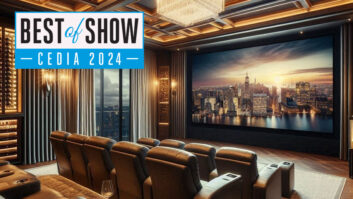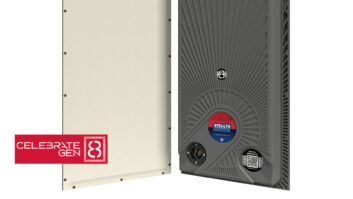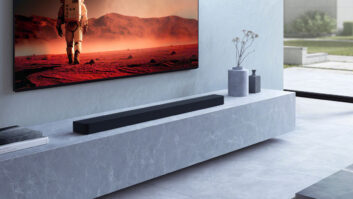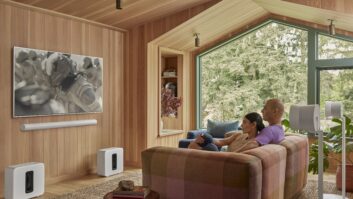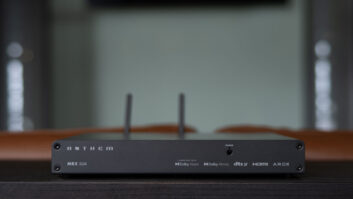In the early 1980s, the company for which Steve Haas worked was hired to acoustically transform an old movie palace in downtown Indianapolis into the new home of the city’s symphony orchestra. Because of its originally intended function, the ornately designed facility did not possess the ideal shape, cubic volume, seating or stage configuration necessary to achieve proper symphonic acoustics. It was, therefore, going to be the job of Haas and his colleagues to find a proper solution without raising the roof (literally) or altering any other major structural elements of the theater, which was listed on the registry of historic places.
So for the Indianapolis Symphony, the choice was to either abandon the theater or consider the use of electronic enhancement to augment the deficient acoustic environment. Having chosen the latter, the Symphony has been performing in an electronically enhanced facility with great success for more than two decades.
That project and many subsequent others have provided Haas, now a self-employed acoustical consultant and owner of SH! Acoustics, with the type of experience that led to his present foray into the world of residential acoustics. His Concertino system is an ultra high-end digital signal processing (DSP) system that provides a very specialized client base with a way to improve inferior acoustical spaces where live musical performance events are often staged. It was Haas’ realization that the needs of commercial and residential acoustical spaces were similar that inspired to begin engineering products exclusively for the home.
“I had been involved in two consulting careers for many years, designing world-class performing arts and museum spaces on one hand and high-end home theaters on the other,” Haas explained. “My communication with clients and designers from all bases allowed me to see that more and more overlap in function was occurring–major multimedia presentations were happening in the commercial facilities and live performance was happening in the home.”
This is what sparked the concept of Concertino (866.277.9700; e-mail [email protected]). “It was the answer to allowing people to perform, rehearse or just enjoy listening to live music in an average size space in their homes and not have it sound dull and lifeless based on the naturally dead acoustics of the home,” Haas added.
Concertino, which literally means “little concert,” is based on electronic enhancement technology, which incorporates digital processing algorithms to vary the apparent size and “liveness” of a space by precisely adjusting the timing and frequency characteristics of each sound reflection. Concertino supports a wide variety of live performances and presentations without requiring any physical changes to the room.
The audio chain of a typical Concertino system involves eight or more microphones with different pickup patterns concealed around a room. The output signals from these microphones are fed into a high-quality microphone preamplifier. The outputs of the preamplifier are sent into the Concertino processor, which is an 8-in/16-out device. Multiple processing units can be daisy-chained for larger spaces, if necessary.
To have near-infinite flexibility for achieving realistic sounding acoustic environments, the Concertino system enhances three primary acoustical measures of real concert facilities: early reflections, reverberation time and “low-end rise.” Early reflections are those sound reflections that arrive at listeners’ ears within 50 ms after the direct sound and combine with direct sound to give presence, clarity and intelligibility to the music or speech. The reverberation time (RT) and level in the room is a measure of the room’s liveness.
“The ideal RT varies tremendously based on the performance use and even the specific piece of music being played,” Haas explained. “While home theaters are design to have mid-frequency RTs of 0.3-0.6s, drama theaters typically have RTs in the 1.0-1.2s range, opera houses in the 1.4-1.6s range, concert halls in the 1.8-2.2s range and cathedrals in the 2.5s and higher range. Classical music was often written to be played in a hall of specific reverberation characteristics.”
While mid-frequency reverberation time is extremely important, Haas noted that the best concert spaces all have an extended low-frequency reverberation time that is 20-25 percent longer than the mid-frequency time. “This promotes the natural resonance and warmth of the lower register instruments and creates a very enveloping feel within the audience,” he said.
The Concertino processor analyzes all of the live signal inputs from the microphones, divides the signals in the time and frequency domains, applies unique algorithms that create the early reflections, reverberation and low-frequency warmth and then outputs these transformed signals to a 16-channel network of amplifiers and loudspeakers. The software interface provides extensive control in the level, blend, equalization and matrix output from each processor channel.
Amplifiers in the Concertino system typically need relatively low power, because the signals are not actually being amplified beyond what their natural energy level would be like in the equivalent concert space. Typical wattage per channel might be less than 25W for the reverberation channels and less than 100W for the early reflection channels. It should be noted that this has no bearing on the power of the source (loudspeaker or instrument).
Haas says that “many” loudspeakers are necessary in a Concertino system to create the “continuously enveloping feel” around the room. “We place loudspeakers both laterally and overhead,” he explained. “Speakers and other sound delivery devices would ideally be wide dispersion and flat response. Localization of the loudspeakers, in any case, is not desirable. The early reflections field may consist of four to eight loudspeakers concentrated in the front half of the room around the source. The reverberation field may consist of eight to 12 speakers in all areas of the room. The smooth response low-end warmth field can be created in a very similar way that subwoofers are balanced in a home theater. Some of the best bass management concepts consisting of four, eight or even 12 or more subwoofers would very much apply to the needs of Concertino.”
Concertino allows the source–whether it’s a string quartet or a pair of loudspeakers playing 2-channel–to play into the room unaltered, but then actually creates live-performance acoustic environments in the room. “Imagine the listener and that musician or loudspeaker (playing your favorite concert CD/DVD) have suddenly been whisked to Carnegie Hall, to Birdland or to Notre Dame Cathedral with the press of a button,” Haas illustrated. “The audience experiences the enhancement as much as the source. Whether it’s the performer playing or the audience clapping, they will both feel like they are listening in that particular concert space.”
The Concertino system has the ability in its hardware and software to separately and collectively adjust all of these parameters to any degree, thus being able to truly recreate the signature acoustic patterns of just about any theoretical or actual type of performance space.
When developing their DSP, Haas and his design partners did not start from scratch. Instead, they reviewed existing commercial products to find a manufacturing partner with a head start. “My design partners and I considered all existing commercially available electronic enhancement systems based on sound quality, ability to scale down the cost to be more affordable to the high-end residential market (commercial installations, including design and tuning, have exceeded a million dollars on many occasions) and the willingness and expertise to work with us to customize the electronic configuration and algorithms to meet the specific acoustic limitations of smaller residential spaces,” Haas noted. “Out of the 8-10 systems we reviewed, our current technology partner clearly was the only one able to meet all of the above criteria and more. They also have been producing over 100 large systems a year for commercial applications since 2000, and have the production facilities and expansion capabilities to build to our demand. Our customized Concertino systems are finalized and have already been prepped for shipping to some of our up-and-coming showrooms.”
When customizing a systems for a specific residential client, Haas and his team (lead electro-acoustic designer Anthony Nittoli and project director Andrew Schmidt) will conduct an initial interview with to determine lifestyle needs, what styles of live music the client enjoys and what types of concert spaces they might want to produce. Although the company has already begun and will continue to develop a range of standard Concertino “rooms” that will be based upon its vast listening and design experience in real performance spaces, for some clients this may not be enough.
“We have the capability of truly modeling any space in the world–from Boston Symphony Hall to the local community theater at which the homeowner spent his childhood years attending performance,” Haas said. “These models can then be defined within the Concertino system to create the acoustic character of the specific hall and implement that as a preset. We can even design a ‘hall’ from scratch, working with the homeowner who may be a performer, to truly optimize a space for their instrument or playing style. Since a large amount of configurations can be saved as presets, the performers and listeners can achieve a wide variety of experiences all during the same performance, if desirable.”
In bringing this new experience to the high-end home market, Haas and partners want to make sure that homeowners and dealers who invest in Concertino are well supported in all respects from their company. Specifically, he believes that the only way for someone to really understand the technology’s benefits is to hear and experience it live. This is why showrooms are extremely important to Concertino, as a near-term business goal.
Concertino presently has one temporary showroom in New York City (a partnership with Theo Kalomirakus’ TK Theaters) and will be expanding to a bigger and better showroom there soon. In the meantime, the company also has showrooms in the works in Denver, Los Angeles and San Francisco with more dealers contacting them weekly to consider including Concertino as part of their new facility.
Once a dealer or client has committed to Concertino, Haas wants them all to be able to take continued advantage of his company’s market studies, technological advances and performer relations. With this in mind, he has hired two of Juilliard’s top graduate musicians, Heidi Torvik on flute and Sarah Koo on cello, in part-time positions as both performers and musical consultants to develop professional musician networks in the specific regions of the Concertino installations. Clients and dealers needing a top-notch musician or group for a demo or performance will be able to call our toll-free number and have Concertino put them in touch with a top-quality performer that best matches their specific needs.
“Our performers/musical consultants will also be involved in many aspects of demonstration, final tuning and further subjective research to advance our experience with a wide variety of instruments and musical styles,” Haas added.
The Concertino Team will be looking to custom dealer/installers to partner with them on each project the design, to provide the traditional system equipment (loudspeakers, amplifiers, wire, etc.) and installation services. On a typical project, they will conduct the initial client interview and then provide full design documents and installation instructions to the custom installer.
“We will furnish the custom-configured hardware/software processing system to the dealer, assist with questions and site reviews during the installation process and then provide final tuning and optimization–both electronically and with live performers. We can even arrange with the client to put together a ‘gala opening’ for the Concertino Hall.”
Interested dealers will need to show that they have a proven track record in the purchase, installation and servicing of high-quality audio/video equipment in the luxury home market. It is important to note, however, that this is not for the average consumer-level purchase. The basic Concertino package–including design, engineering, tuning and proprietary equipment–starts at $75,000.
To dealers with whom he may partner, Haas also stresses that Concertino should not be sold merely as an electronic system with a bunch of black boxes. The emphasis, instead, should be placed on the end result as a natural and emotional live-performance experience. “It will provide a whole new form of home entertainment that will distinguish dealers from their competition and homeowners from their friends and business associates. I have spoken to those who had never even been to a symphony concert before, and the feeling for them to hear, for the first time, great music in a wonderful sounding space was just awesome. It is this kind of emotional connection and experience that we want to give both performers and listeners in their home with Concertino.”
-Jeremy J. Glowacki is editor of Residential Systems.
Concertino’s Steve Haas hired two of Juilliard’s top graduate musicians, Heidi Torvik on flute and Sarah Koo on cello, in part-time positions as both performers and musical consultants to develop professional musician networks in the specific regions of the Concertino installations.
Concertino presently has one temporary showroom in New York City (a partnership with Theo Kalomirakus’ TK Theaters, pictured) and will be expanding to a bigger and better showroom there soon. Haas recently added Andrew Schmidt, a project director, to work with the Concertino system. In bringing this new experience to the high-end home market, Haas and partners want to make sure that homeowners and dealers who invest in Concertino are well-supported in all respects from their company

